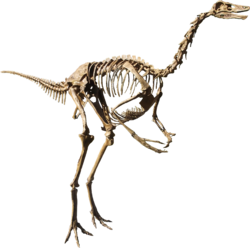Struthiomimus
|
Struthiomimus Temporal range: Late Cretaceous, 77–66 Ma |
|
|---|---|
 |
|
| Cast of an S. altus skeleton, Rocky Mountain Dinosaur Resource Center | |
| Scientific classification | |
| Kingdom: | Animalia |
| Phylum: | Chordata |
| Class: | Reptilia |
| Clade: | Dinosauria |
| Order: | Saurischia |
| Suborder: | Theropoda |
| Clade: | †Ornithomimosauria |
| Family: | †Ornithomimidae |
| Genus: |
†Struthiomimus Osborn, 1917 |
| Type species | |
|
†Struthiomimus altus (Lambe, 1902) |
|
Struthiomimus (meaning "ostrich mimic", from the Greek στρούθειος/stroutheios meaning "of the ostrich" and μῖμος/mimos meaning "mimic" or "imitator") is a genus of ornithomimid dinosaurs from the late Cretaceous of North America. Ornithomimids were long-legged, bipedal, ostrich-like dinosaurs with toothless beaks. The type species, Struthiomimus altus, is one of the more common small dinosaurs found in Dinosaur Provincial Park; its abundance suggests that these animals were herbivores or omnivores rather than pure carnivores.
The size of S. altus is estimated as about 4.3 metres (14 ft) long and 1.4 metres (4.6 ft) tall at the hips, with a weight of around 150 kilograms (330 lb).
Struthiomimus had a build and skeletal structure typical of ornithomimids, differing from closely related genera like Ornithomimus and Gallimimus in proportions and anatomical details. As with other ornithomimids, they had small slender heads on long necks (which made up about 40% of the length of the body in front of the hips). Their eyes were large and their jaws were toothless. Their vertebral columns consisted of ten neck vertebrae, thirteen back vertebrae, six hip vertebrae, and about thirty-five tail vertebrae. Their tails were relatively stiff and probably used for balance. They had long slender arms and hands, with immobile forearm bones and limited opposability between the first finger and the other two. As in other ornithomimids but unusually among theropods, the three fingers were roughly the same length, and the claws were only slightly curved; Henry Fairfield Osborn, describing a skeleton of S. altus in 1917, compared the arm to that of a sloth. These might have been adaptations to support wing feathers.
...
Wikipedia
